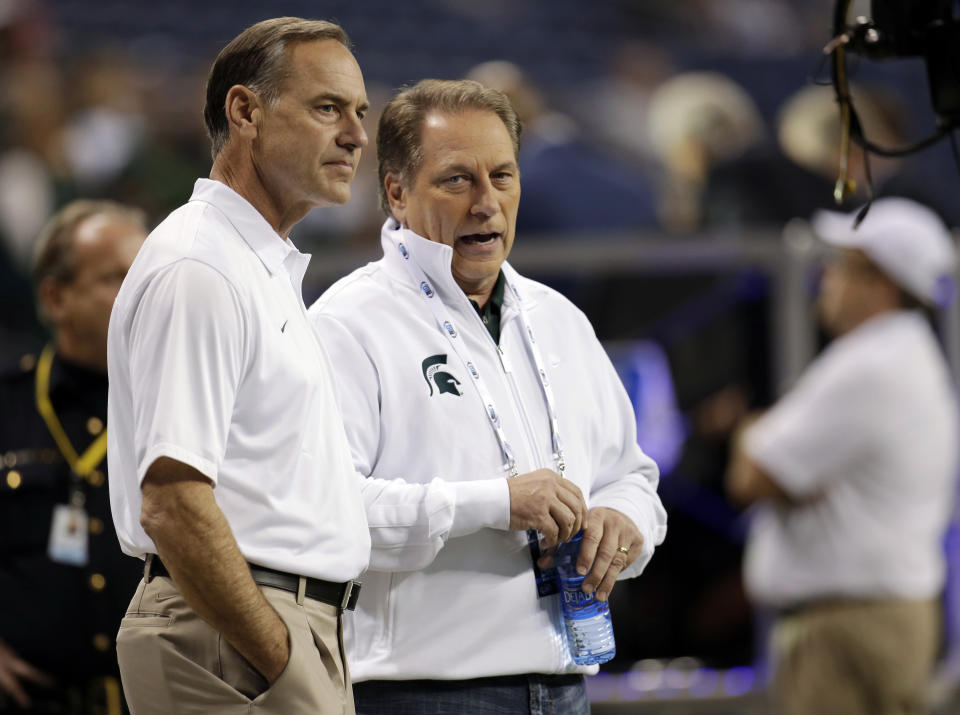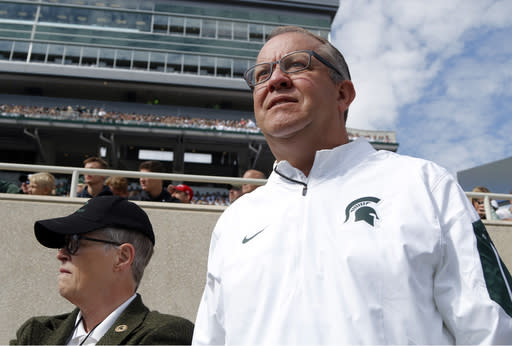It's becoming clear: Michigan State prized image protection far more than the truth

There were two major stories released Friday concerning the ongoing disaster at Michigan State. One prompted a lot of heat, a lot of sound and fury. The other was more troubling.
ESPN’s Outside The Lines had a lengthy piece that attempted to tie the Larry Nassar abuse atrocities to physical and sexual violence allegations against the school’s football and men’s basketball programs. The ties were tenuous. And while the report gained a lot of traction because it placed Hall of Fame basketball coach Tom Izzo and highly successful football coach Mark Dantonio under scrutiny, it also included a lot of allegations that resulted in charges either not being filed, or being dismissed. Which may ultimately be more of a law enforcement problem than an athletic problem.
That said, I’m not discounting the story, which should help prompt a fearless and thorough review of the entirety of Michigan State’s athletic department – Izzo and Dantonio included – in the wake of athletic director Mark Hollis’ disingenuous retirement Friday. At a crossroads, the school must decide what it wants to be, how it wants to be represented to the world, and who its most public representatives should be.
But the story that appeared in the Lansing State Journal later Friday was bigger. It lacked the more sensational quality of a potential football/basketball scandal, but it strikes more profoundly at the heart of what the Nassar tragedy is all about:
• Disregard for victims.
• An organized institutional effort to deceive, deny and hide the truth, enabling Nassar in the process.
In that story, the State Journal reports that Michigan State’s utterly botched 2014 Title IX investigation of a complaint against Nassar led to two sets of conclusions: a shortened version presented to the victim, Amanda Thomashow, and a more damaging conclusion that was kept from her. The latter version was sent to the university’s Office of General Counsel, Nassar and his boss at the College of Osteopathic Medicine, William Strampel.
The newspaper got both copies of the report. The one that was sent to Thomashow had the following conclusion: “We cannot find that the conduct was of a sexual nature. Thus, it did not violate the Sexual Harassment Policy. However, we find the claim helpful in that it allows us to examine certain practices at the MSU Sports Medicine Clinic.”
The conclusion in the copy that was sent to the others went much further:
“We cannot find that the conduct was of a sexual nature. Thus, it did not violate the Sexual Harassment Policy. However, we find the claim helpful in that it brought to light some significant problems that the practice will want to address.
“We find that whether medically sound or not, the failure to adequately explain procedures such as these invasive, sensitive procedures, is opening the practice up to liability and is exposing patients to unnecessary trauma based on the possibility of perceived inappropriate sexual misconduct. In addition, we find that the failure to obtain consent from patients prior to the procedure is likewise exposing the practice to liability. If procedures can be performed skin-on-skin or over clothes in the breast or pelvic floor area, it would seem patients should have the choice between the two. Having a resident, nurse or someone in the room during a sensitive procedure protects doctors and provides patients with peace of mind. If ‘touching is what DO’s do’ and that is not commonly known, perhaps the practice will want to consider a disclaimer or information sheet with that information provided to the patient up front.
“Finally, we believe the practice should consider whether its procedure for intake of complaints about physicians’ behavior is adequate. Ms. Thomashow claims she tried to file a complaint with the front desk receptionist, telling her that she was canceling her appointment because she felt ‘violated.’ Whether this triggers a reporting protocol should be examined by the practice.”
To keep that from the victim who brought the claim against Nassar is unconscionable. And the fact that Nassar was basically allowed to return to business as usual after being reinstated to his duties – resulting in the subsequent alleged abuse of a more than a dozen young women and girls – is abominable.
Thomashow’s attorney, Jim Graves, told the State Journal: “MSU had the audacity to keep a second version of the same report undisclosed to my client and the public until now.”
The two major news stories dovetail across one commonality: Michigan State, like so many schools, prized image protection far more than transparency and truth. When the first instinct in the face of trouble is to lie, deny, deflect and hide, you have the breeding ground for awful things to happen.
Ask Penn State. Ask Baylor.
And now, today, you also have to ask Mark Hollis. An innovative and popular athletic director, Hollis “retired” Friday, including this sentence in his statement: “I’m not running away from anything.” But very shortly thereafter the Outside The Lines story dropped, and it was clear that Hollis knew it was coming and had no interest in riding that storm out.
It might have been impossible to do so anyway. Because among the most troubling aspects of the OTL story was the fact that Hollis reportedly personally took on the investigation of an alleged sexual assault involving members of the basketball program in 2010. There was no public resolution to the situation, which involved two unnamed players and student assistant Travis Walton.

The players continued in their roles with the Spartans. Walton, according to OTL, was privately fired.
Hollis had about as much business heading an investigation of that sort himself as he would teaching a class at Michigan State’s College of Human Medicine. A persistent problem with university investigations is that criminal allegations are turned over to people without any background in that field. Hollis is an athletic director. The woman who headed MSU’s Title IX investigation, Kristine Moore, was a labor lawyer.
Hollis exited the smoldering ruins in East Lansing on Friday, and now the question is whether other dominoes will fall. Namely Dantonio and Izzo, the two most prominent employees of Michigan State.
I don’t believe the OTL report is enough to force a dismissal of either man – but it’s fair to at least have conversations about whether they’re doing everything the way a deeply scarred university wants them to.
Every school engaged in the Faustian bargain of big-time athletics must weigh its tolerance for the unsavory against the regard for its own reputation. And when those two come in conflict, the only acceptable approach is to meet the situations honestly and forthrightly.
As two news reports Friday showed, Michigan State has failed the honest and forthright part. To disastrous effect.

